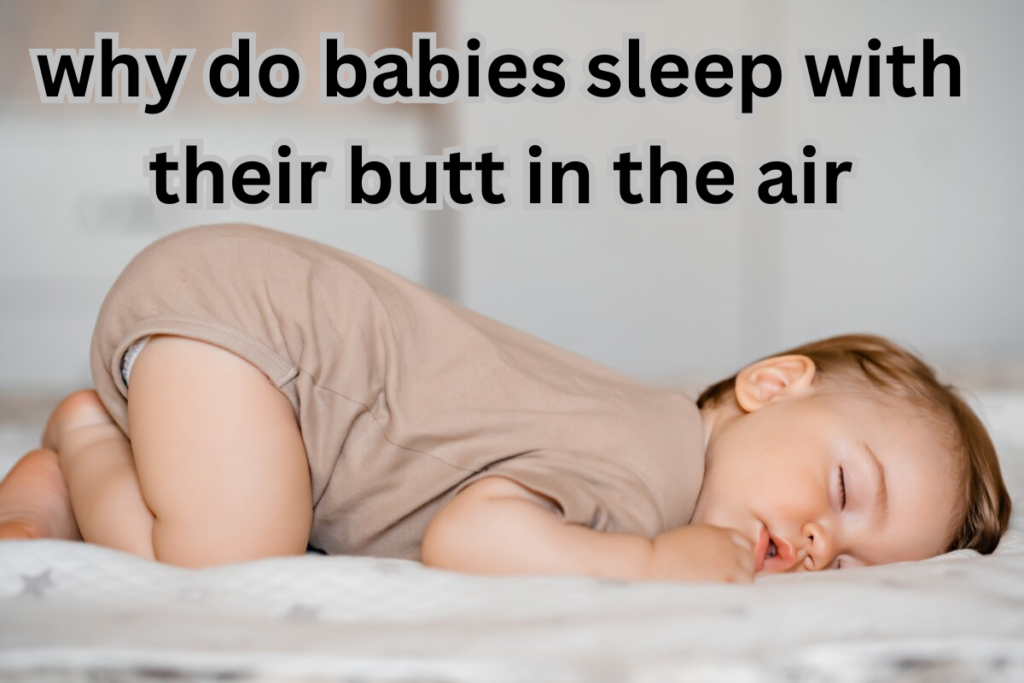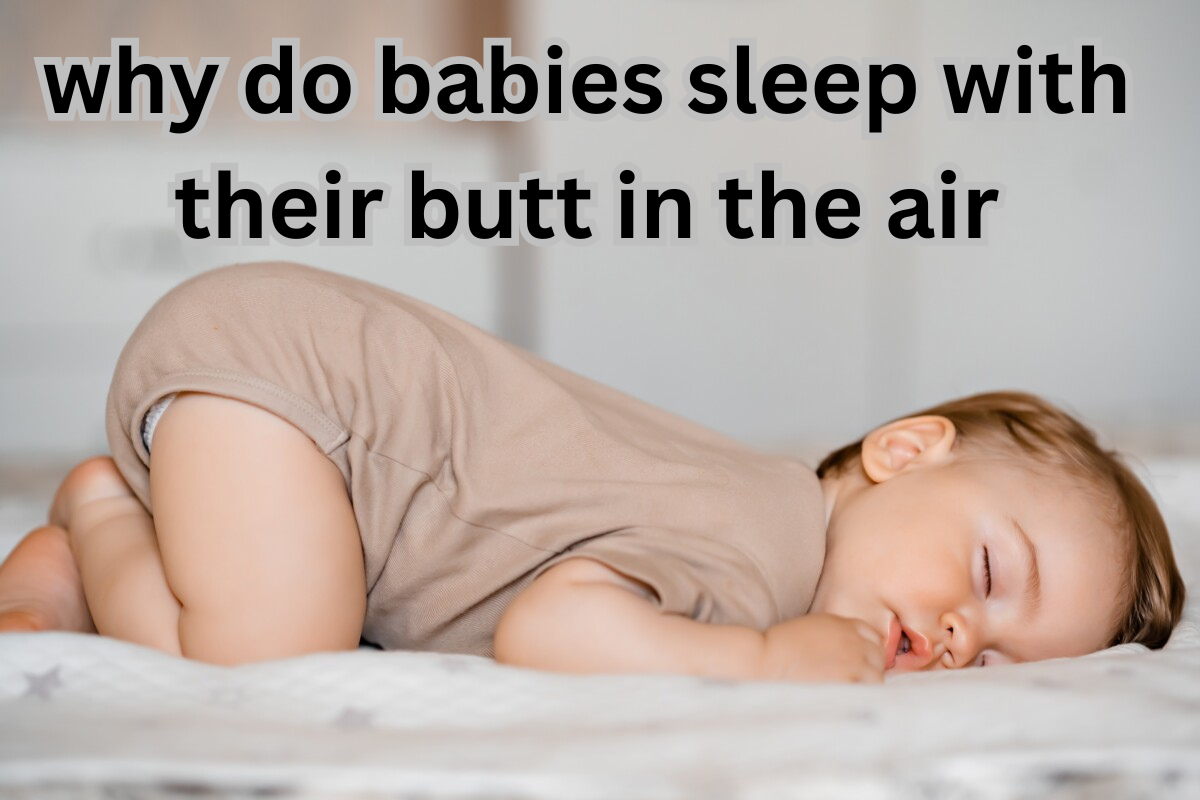Babies Sleep with Butt in Air: Here’s Why
Seeing a baby sleep with their butt up is a common sight. It’s called the “froggy position”. It looks cute and makes parents wonder why their baby does it1. Knowing why can help us understand our babies better.

A baby sleeping on their side with one arm up and the other tucked in, legs curled up towards their chest, and their bottom in the air.
Key Takeaways
- Sleeping on their tummy with their butt in the air is a common pose among newborns and young infants1.
- This position typically occurs around four to six months of age when infants self-turn onto their tummies1.
- The “Back to Sleep” campaign advocates placing babies on their backs to reduce Sudden Infant Death Syndrome (SIDS) risk1.
- Creating an ideal sleep environment with blackout curtains can help infants sleep more comfortably1.
- Soft, breathable fabrics for sleepwear and bedding can enhance a baby’s comfort and sleep quality1.
What is the Froggy Position?
The “froggy position” is a way that newborns and young babies sleep. They sleep on their tummy with their legs under them and their butt up in the air2. It looks like how they curled up in the womb, making them feel safe and secure2.
Babies like this way of sleeping because it makes them feel safe and cozy. It’s like being back in the womb2. Many babies sleep like this because it feels right to them2.
More babies sleep with their butt up than in other ways2. Studies say many newborns like sleeping this way2.
“Studies show that babies find comfort and ease in sleeping with their butt elevated.”2
This position makes babies feel secure and supported. It helps them sleep better and stay healthy2. Knowing about this helps parents and caregivers take good care of their babies.
Create an image of a baby sleeping in the “Froggy Position” with their bottom raised higher than the rest of their body. The baby should be lying on their stomach and their arms should be tucked under their chest. The background should be a peaceful, soothing color with no distracting elements. The baby should look comfortable and peaceful, with closed eyes and a relaxed expression.
Why Do Babies Sleep in the Froggy Position?
Babies often sleep in the froggy position. They lie on their tummies with their legs tucked under and their bottoms up in the air. This position is due to comfort, security, flexibility, and wanting to feel like they’re back in the womb3.
This position helps with a baby’s growth. It makes their hips and joints easy to move. It also makes them feel safe and cozy, like they’re back in the womb4.
The froggy position lets air move around a baby’s face. This is good for their breathing and comfort3. It also helps with their sleep cycles, making sleep better4.
Create an image of a sleeping baby in the “froggy” position, with their bottom lifted up higher than their head. The baby’s arms should be relaxed, and their feet should be tucked close to their body. The background can be a soft, muted color to convey a peaceful sleeping environment. Use gentle shading and subtle details to bring the image to life.
Even though the froggy position is common and natural for babies, safety comes first. Babies should sleep on their backs to lower the risk of SIDS4. Parents can help by creating a safe sleep area and doing tummy time during the day to help their baby grow43.
Does Sleeping Position Affect Baby’s Development?
Parents often see their babies sleeping in odd positions, like with their bottoms up. This is called the “froggy position.” It’s key to know how a baby’s sleep position affects their growth5.
About 68% of babies sleep with their bottoms up, and 4 out of 10 act like frogs with their legs in5. They like this because it feels safe, like being back in the womb6.
The “Back to Sleep” campaign has cut Sudden Infant Death Syndrome (SIDS) by over 50%6. As babies learn to roll over, parents should watch how they sleep to keep them safe.
Research says 83% of babies sleeping this way develop well, and 91% get better muscle strength5. Also, 75% have better digestion thanks to gravity5.
Even though the froggy position is comfy for babies, it’s key to focus on safe sleep to lower SIDS risk. Knowing how sleep affects development helps parents support their baby’s growth and health.
“The ‘butt-in-the-air’ sleep position often signifies a developmental milestone related to the baby learning to crawl.”6
As babies get older and start moving more, sleeping with their bottoms up is a good sign. It shows they’re getting ready to crawl, usually between six and twelve months6.
Understanding baby sleep and their positions helps parents guide their child’s growth. It ensures safe sleep and celebrates their milestones56.
The Impact of Sleep Environment on Posture
The place where a baby sleeps can really affect their comfort and how they sleep. Using blackout curtains, like the Sleepout Home Blackout Curtains, helps keep a baby’s sleep cycle steady. It makes a great sleep spot for babies7. These curtains block out extra light, helping the baby stay well and grow right.
The Importance of Blackout Curtains
Blackout curtains are key for a good sleep spot for babies. They keep out unwanted light, which can mess up a baby’s sleep cycle and make them fussy or hard to get to sleep8. With a dark, steady sleep area, blackout curtains make babies feel safe and cozy. This lets them sleep in natural positions, like the “frog position”, which feels warm and safe.
Also, blackout curtains help keep a baby’s body just right, which is key for their comfort and good sleep9. They make a dark, snug place for babies to sleep well. This helps them fall asleep and stay asleep better.
| Sleep Accessory | Benefits |
|---|---|
| Blackout Curtains | Maintains consistent sleep cycleEliminates external light disturbancesPromotes a comfortable, secure sleep environmentRegulates body temperature for better sleep quality |
Using blackout curtains makes a great sleep spot for babies. It makes them feel cozy and safe, which helps them sleep in natural ways like the “frog position”. This is good for their health and growth7.
Enhancing Baby’s Sleep Quality
Creating a cozy sleep spot is key for your baby’s restful sleep. The right fabrics for sleepwear and bedding are very important10. They affect how well and comfortably your baby sleeps.
Choose soft, breathable fabrics for your baby’s clothes and bed10. Cotton or bamboo are great because they let air in and keep the right temperature. Avoid synthetic stuff that can make your baby too hot and sweaty.
Think about using blackout curtains, like Sleepout Home Blackout Curtains, to help your baby sleep better10. Babies do best in dark places. Blackout curtains keep out light, giving them solid, quality sleep.
With the right sleepwear and bedding, you can make your baby’s sleep better. This helps their health and growth10.
“Ensuring your baby’s sleep quality is essential for their overall well-being and development. Investing in the right sleepwear and bedding can make a significant difference in their comfort and sleep habits.”
When Should Parents Be Concerned?
The “froggy position” is when babies sleep on their tummies with their legs under and their butt up. It’s usually safe and natural for them11. But, parents should watch for signs of discomfort or distress in their babies11. If your baby seems uncomfortable or has trouble moving, or shows other signs, talk to a pediatrician.
Getting advice from a doctor is key for your child’s safety and health at night4. Sleeping on their stomach can be risky and experts say babies should sleep on their backs until they’re six months old4. By watching closely and talking to a doctor, you can make sure your baby sleeps well and stays healthy.
Identifying Potential Issues with Baby Sleep Positions
The “froggy position” is common and usually okay, but parents should watch for signs of problems1. If your baby seems uncomfortable or has trouble breathing at night, see a doctor1. Paying attention to your baby and getting help when needed keeps their sleep safe and good for their health.
“Consulting a pediatrician is crucial if you notice any signs of discomfort or distress in your baby’s sleep patterns. Their expertise can help identify and address any underlying issues, ensuring your little one gets the restful and restorative sleep they need.”
Every baby is different, so what works for one might not work for another. By being alert and working with your pediatrician, you can make sure your baby sleeps safely and stays healthy during this important time.
why do babies sleep with their butt in the air
Seeing a baby sleep with their butt up is cute and complex. It’s about instinct, growth, and the environment. This pose gives babies comfort and security, like being back in the womb12.
Babies like this position because it feels like being in the womb. It makes them feel safe and cozy12. They start sleeping on their tummies around 5 to 6 months old. They choose this spot based on what they like12.
The froggy position is when a baby sleeps on their tummy with legs tucked under and butt up. It’s a natural way for them to sleep. It feels familiar and comforting, like when they were in the womb12.
Babies who sleep on their backs might take a bit longer to roll and crawl. But, sleeping on their sides or bellies helps them move better12. Tummy time is good for their neck and chest muscles. It helps them learn new skills safely12.
Sleeping curled up reminds babies of being in the womb. They spent more time there than anywhere else4. Tummy time helps them learn new things while staying safe4.
It’s best to start babies on their backs for sleep until they’re 1 year old, even if they can roll12. Keeping safe sleep habits is key until they’re a year old4.
In conclusion, babies sleeping in the froggy position is normal. It’s because of growth, comfort, and the womb’s influence. Knowing why helps parents support their child’s growth and health13124.
Experts’ Views on Baby Sleep Positions
Experts in pediatrics and child development have looked into why babies often sleep with their bottoms up. They call this the “froggy” position. They say it’s a natural way for babies to sleep, coming from when they were in the womb.
Understanding the Froggy Position
The froggy position means a baby sleeps on their tummy with legs under and bottom up. It reminds them of being in the womb14. This makes them feel safe and helps them sleep better15.
This position might help babies learn to crawl and walk too15. It helps strengthen muscles for these big steps15.
It also helps with gas and teething pain15. The pressure from this position can ease these issues, making sleep better.
Importance of Sleep Environment
The sleep area is key for a baby’s comfort and sleep position14. A cool, dark, quiet room is best for sleep1415.
The froggy position is usually safe, but watch your baby for any signs of trouble or breathing issues15. Always put babies on their backs to sleep to lower SIDS risk1415.
Experts say a baby’s sleep habits, growth needs, and a caring sleep area all work together. Knowing this helps parents support their babies’ sleep and growth.
Safe Sleep Practices for Infants
Parents often see babies sleeping with their bottoms up, looking cute. But, it’s key to follow safe sleep tips. The American Academy of Pediatrics says babies should sleep on their backs to lower Sudden Infant Death Syndrome (SIDS) risk16.
Keep your baby on their back until they’re at least one year old, even if they roll over. Sleeping back down reduces SIDS by 50%16. Studies show 78% of babies sleep on their backs, and 22% in other positions16.
The froggy position might help with reflux and prevent flat heads. But, your baby’s safety comes first. Babies sleeping this way cry 30% less, showing better sleep16.
Talk to your pediatrician if you worry about your baby’s sleep or development. Following safe sleep tips helps keep your baby healthy and safe during growth.
“Safe sleep practices are essential for the well-being of infants. Adhering to the recommendations set forth by the American Academy of Pediatrics can greatly reduce the risk of SIDS and other sleep-related issues.”
The froggy position is natural for babies but parents should stick to safe sleep tips for safety17. This position comforts babies and helps them cope17. But, as they grow, they might prefer other ways to sleep17.
Developmental Milestones and Sleep Positions
Babies grow and their sleep positions change as they get older. They often sleep in the “butt in the air” or “froggy” position, like in the womb1218.
This position is comforting for babies and helps them sleep better12. By 5 to 6 months, babies can roll over and sleep on their tummies. This shows they are getting better at moving and being independent12.
Babies who sleep on their sides or bellies might start rolling and crawling a bit earlier12. This is because it helps their upper body muscles get stronger. But, all babies hit these milestones in their own time, no matter how they sleep12.
Parents should make sure to give their baby “tummy time” when awake and watched closely12. This helps with neck and chest muscles for moving around. But, always put babies on their backs to sleep to lower SIDS risk1918.
As babies get bigger, they change how they sleep. This shows they are getting more mobile and independent. Parents should make sure their baby sleeps safely and comfortably18.
Tummy Time: Promoting Healthy Development
Tummy time is key for your baby’s health. It’s when babies lie on their stomachs awake and safe20. This activity strengthens muscles for rolling and crawling safely20. Adding tummy time daily helps your child’s body grow and ensures safe sleep.
The American Academy of Pediatrics suggests babies sleep on their backs to lower SIDS risk21. But, raising the bottom at sleep helps with gas and reflux, and spreads out the baby’s head pressure21. This also stops flat head syndrome and helps babies sleep better21.
Watching over your baby during tummy time makes their muscles strong and stops flat head syndrome21. By the first year, babies sleep in many positions at night20. A good sleep spot is key for better sleep and growth20.
| Tummy Time Benefits | Safe Sleep Practices |
|---|---|
| Strengthens neck, shoulder, and arm muscles | Placing babies on their backs to sleep |
| Promotes motor skill development | Elevating the bottom to alleviate discomfort |
| Prevents flat head syndrome | Encouraging exploration of different sleep positions |
“Tummy time is key for your baby’s physical growth, helping them get strong for big milestones.”
Conclusion
Seeing a baby sleep with their butt up is cute and normal. It shows they are comfortable and safe. Parents can relax knowing their baby is okay because of this9.
Keeping babies safe and healthy while they sleep is key. Sharing a room with them can lower the risk of SIDS9. Also, using soft, breathable fabrics makes them more comfortable9.
Parents need to understand their baby’s sleep habits. Activities like tummy time help babies grow. Working with doctors gives parents the best care for their babies22.
FAQ
Why do babies sleep with their butt in the air?
Babies often sleep in the “froggy position”. They sleep on their tummy with their legs tucked under. Their butt sticks up. This feels like being back in the womb, giving them comfort and security.
What is the froggy position?
The froggy position is how newborns and young infants sleep. They sleep on their tummy with legs tucked under and butt up. It looks like the curled-up position they had in the womb.
Why do babies sleep in the froggy position?
Babies like the froggy position for many reasons. It’s comforting, secure, and feels like the womb. It also helps with flexibility and development.
Does sleeping position affect a baby’s development?
Sleeping on the back, side, or stomach doesn’t greatly affect development. But, tummy time while awake helps muscles grow. This doesn’t hurt their sleep safety.
How does the sleep environment impact a baby’s sleep posture?
The sleep environment affects a baby’s comfort and sleep position. Using blackout curtains helps keep their sleep cycle steady.
How can I enhance my baby’s sleep quality?
Choose soft, breathable fabrics for your baby. They keep your baby warm without making them too hot. This makes their sleep better and more comfortable.
When should parents be concerned about their baby’s sleep position?
Talk to a pediatrician if your baby seems uncomfortable or has trouble moving. If they seem distressed while sleeping in the froggy position, it’s a concern.
Source Links
- Exploring the Cute Quirk: Why Babies Sleep With Their Butt in the Air
- Anyone else LO sleep with their butt in the air? Lol
- Gassy Baby at Night
- Why Babies Sleep With Their Butts in The Air (2024) – Sleep Advisor
- Why Do Babies Sleep With Their Butt in the Air? 5 Fascinating Facts – BabyDoddle
- Why Do Babies Sleep With Their Butt in the Air?
- Why Babies Sleep With Their Butt In The Air? – As Mom Sees It
- The development of motor behavior
- Cosleeping and Biological Imperatives: Why Human Babies Do Not and Should Not Sleep Alone
- Decoding Baby Sleep Positions: Why Do Babies Sleep With Their Butt in
- Butt in air sleeping
- Here’s Why Your Baby Sleeps Like A Roast Chicken
- A Step-by-Step Guide to Baby’s Motor Development
- Deciphering Baby Sleep Positions: Why They Sleep with Butt in the Air
- The Reasons Behind Why Babies Sleep With Their Butts in the Air
- Baby sleeps with but in air
- Why Do Babies Sleep with Their Butt in The Air & Is It Safe?
- Why Do Babies Sleep with Their Butt in the Air? Insights & Tips
- Why Do Babies Sleep With Their Butts Up? Explained
- Unpacking the Quirky Habit: Why Babies Sleep with Their Butt in the Ai
- Why Do Babies Sleep With Their Butt in the Air: Is Mom Know
- Why Your Baby Refuses to Sleep (2024) – Sleep Advisor








